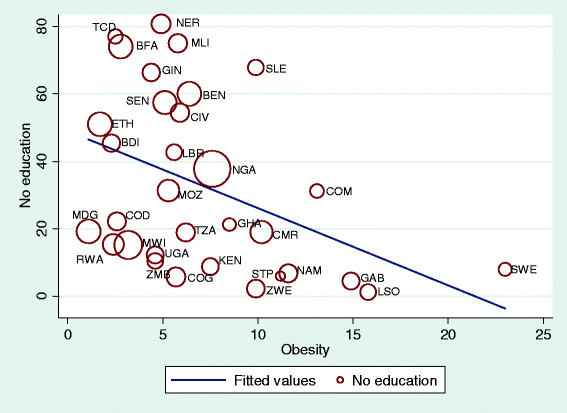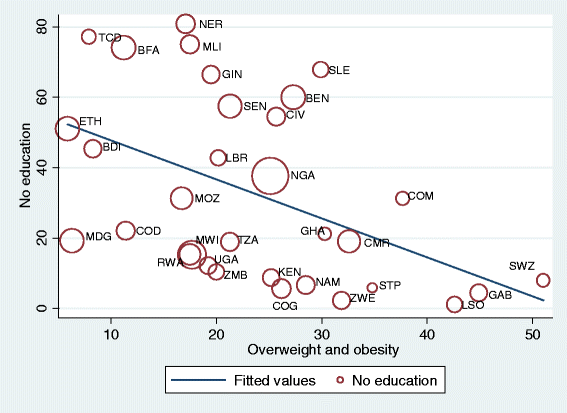Overweight and obesity among women: analysis of demographic and health survey data from 32 Sub-Saharan African Countries
- PMID: 26758204
- PMCID: PMC4710980
- DOI: 10.1186/s12889-016-2698-5
Overweight and obesity among women: analysis of demographic and health survey data from 32 Sub-Saharan African Countries
Abstract
Background: Overweight and obesity are risk factors for many chronic diseases globally. However, the extent of the problem in low-income countries like Sub-Saharan Africa is unclear. We assessed the magnitude and disparity of both phenomena by place of residence, level of education and wealth quintile using cross-sectional data from 32 countries.
Methods: Demographic and Health Survey (DHS) data collected in 32 Sub-Saharan African countries between January 2005 and December 2013 were used. A total of 250651 women (aged 15-49 years) were analyzed. Trained personnel using a standardized procedure measured body weight and height. Body mass index (BMI) was calculated by dividing body weight by height squared. Prevalence of overweight (25.0-29.9 kg/m(2)) and obesity (≥ 30.0 kg/m(2)) were estimated for each country. Analysis of the relationships of overweight and obesity with place of residence, education and wealth index were carried out using logistic regression.
Results: The pooled prevalence of overweight for the region was 15.9% (95% CI, 15.7-16.0) with the lowest in Madagascar 5.6% (95% CI, 5.1-6.1) and the highest in Swaziland 27.7% (95% CI, 26.4-29.0). Similarly, the prevalence of obesity was also lowest in Madagascar 1.1% (95% CI, 0.9-1.4) and highest in Swaziland 23.0 (95% CI, 21.8-24.2). The women in urban residence and those who were classified as rich, with respect to the quintile of the wealth index, had higher likelihood of overweight and obesity. In the pooled results, high education was significantly associated with overweight and obesity.
Conclusions: The prevalence of overweight and obesity varied highly between the countries and wealth index (rich vs. poor) was found to be the strongest predictor in most of the countries. Interventions that will address the socio-cultural barriers to maintaining healthy body size can contribute to curbing the overweight and obesity epidemic in Africa.
Figures



References
-
- Ng M, Fleming T, Robinson M, Thomson B, Graetz N, Margono C. Global, regional, and national prevalence of overweight and obesity in children and adults during 1980–2013: a systematic analysis for the Global Burden of Disease Study 2013. Lancet. 2014;384:766–81. doi: 10.1016/S0140-6736(14)60460-8. - DOI - PMC - PubMed
-
- Lim SS, Vos T, Flaxman AD, Danaei G, Shibuya K, Adair-Rohani H, et al. A comparative risk assessment of burden of disease and injury attributable to 67 risk factors and risk factor clusters in 21 regions, 1990–2010: a systematic analysis for the Global Burden of Disease Study 2010. Lancet. 2012;380:2224–60. doi: 10.1016/S0140-6736(12)61766-8. - DOI - PMC - PubMed
-
- World Health Organization . Obesity and overweight. 2013. p. 311.
-
- World Health Organization . WHO obesity: preventing and managing the global epidemic; 894. 2000. pp. 1–253. - PubMed
MeSH terms
LinkOut - more resources
Full Text Sources
Other Literature Sources
Medical

